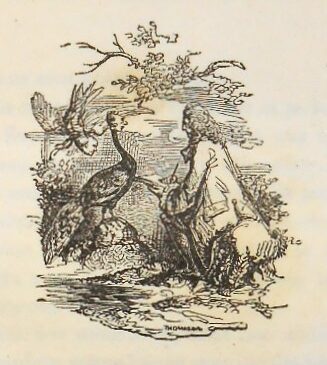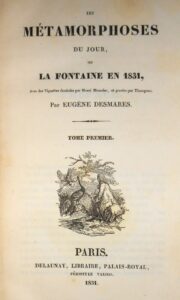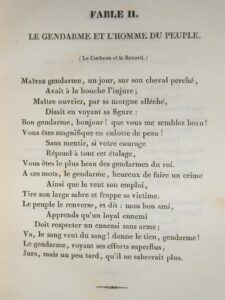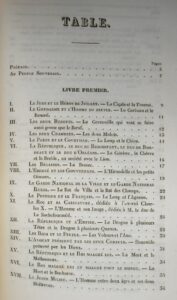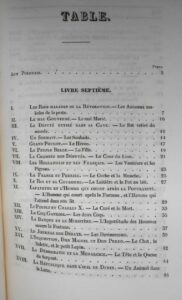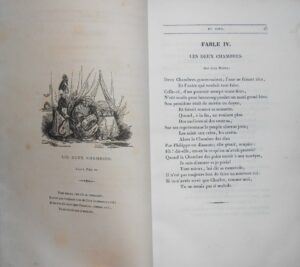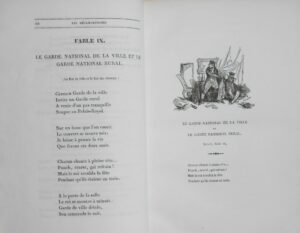Eugène Desmares. Les Métamorphoses du jour, ou La Fontaine en 1831. Paris, Delaunay, 1831. 2 vol. in-8°, 256 pp. [numbered VI-[7-9]-256] ; 319 pp. Half-night blue long-grained morocco with corners, long romantic spine, gilt title, raised title and tomaison boxes, gilt place and year at foot, gilt fillet on covers, untrimmed (Binding end of the 19th century).
“Extremely rare” original edition (Rochambeau, 397) ; complete copy with 18 vignettes drawn by Henri Monnier, woodcut by [Charles or John] Thompson (1 repeated on the p. of t., 10 into the t. I and 6 into the t. II, all on full-page folded out of text).
Satirical collection in twelve books of political fables, each becoming a clever parody of a fable wrote by La Fontaine. On the aftermath of the events of July 1830 the journalist Eugène Desmares (dead in 1839) edited these fables converted into revolutionary pamphlets directed against Louis-Philippe accused of having confiscated the revolution of 1830 for its own benefit. Their titles are evocative: La République, le duc de Reichstadt, le duc de Bordeaux et le duc d’Orléans (La Génisse, la Chèvre et la Brebis, en société avec le Lion), Casimir Perrier voulant imiter Metternich (Le Corbeau voulant imiter l’Aigle), Louis-Philippe et la Liberté (Le Charretier embourbé), etc…
The author specifies in his Preface: “Come into our ministries, into our administrations, into our own rooms! they are not animals that you find there; they are not foxes, wolves, buzzards or snakes; they are indeed men! with more or less false eyes, more or less long hands, mouths more or less large; men! in embroidered clothes, liveried, in elegant frac, in cassock; all with a red or blue ribbon. But listen to them speak, their nature changes. […] it is no longer the animals that speak the language of men, but men that of animals. If our beautiful revolution has produced fruits! there they are! And the proof!….. »
Brivois notes that the edition was continued and the author sentenced to 6 months in prison and 500 Fr. fine; Drujon specifies that “this work was continued under the prevention of offenses against the person of the king, prevention contained entirely in the qualification of “Citizen tyrant”, given to the King of the French by the author, in one of his fables entitled: “le Chameau et les Bâtons flottants”. After a short deliberation of the jury, who reached a negative verdict, the author was simply acquitted by judgment of the Assize Court of the Seine, in 25 January 1832. »
Henri Bonaventure Monnier (Paris, 1799 – id., 1877) was a renowned caricaturist of the customs and physiognomies of his contemporaries, from grisette to office worker. He is the creator of the caricatural Monsieur Prudhomme, which Balzac will say that he imposes himself as “the illustrious type of the bourgeois of Paris” and which Paul Verlaine will be inspired by, in Poèmes saturniens, for a homonymous poem. Henry Monnier also served as Balzac’s model for the character of Jean-Jacques Bixiou, caricaturist, man of good words, and who’s in many novels of La Comédie humaine.
“The name of Charles Thompson characterized, with that of Brévière, not the renaissance of wood engraving in France (that would be too much to say, and it is an honor that must be reserved in Porret), but the preparatory period for this renaissance. » (Béraldi : Les Graveurs du XIXth century. Paris, Conquet, 1892, t. XII, p. 118-119). Charles Thompson (Londres, 1789 – Bourg-la-Reine, 1843) came in Paris in 1816 at the insistence of Firmin Didot; he mainly produces vignettes and floral ornaments for polytypes — small engravings reproduced by moulding, which are then resold to printers. Thompson also collaborated with the printer Pillet who would be the first to use wood engraving for real illustrations., and no longer just passe-partout ornaments. Charles Thompson, engraver associated with Achille Devéria as well as other illustrators of the Romantic era, was a huge success during his lifetime. Benezit, XIII, 608. While Béraldi attributes these engravings to Charles, Bassy attributes them to his brother John (Manchester, 1785 – Kensington, 1866) equally famous. Benezit, XIII, 610.
From the library of L. D., with his engraved bookplate.
Rochambeau, 397 ; Carteret : Le Trésor du Bibliophile, III, 198-199 ; Drujon, 257-258 ; Vicaire, III, 215-216 ; Brivois : Bibliographie des ouvrages illustrés du XIXe siècle, Paris, Rouquette, 1883, pp. 122-123 ; Quérard : Supercheries littéraires, 914, n.1 ; Alain Marie Bassy Les Fables de La Fontaine. Quatre siècles d’illustration, Promodis, 1986 ; Benezit, IX, 760 ; Béraldi, XII, 118-119.
Slight wear to corners, hinges rubbed and spine slightly insolated. Fairly clean inside despite some foxing and although several hors-texte vignettes are browned, as is often the case.
Good copy, rare.
650 €
